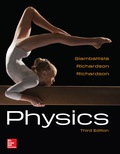
Concept explainers
(a)
Identify the direction of propagation of wave.
(a)
Answer to Problem 83P
Wave propagates in left direction.
Explanation of Solution
The equation of wave is
The direction of wave is determined by whether the argument of cosine function is positive or not. If it is positive, means that the wave is propagating in left direction and negative value indicates the propagation in right direction. For the wave
Therefore, the wave propagates in left direction.
(b)
Identify the maximum distance up to which the particles in the medium will move from the equilibrium position.
(b)
Answer to Problem 83P
Particles can move by
Explanation of Solution
The equation of wave is
Write the standard form of equation for a wave moving along –ve x-axis.
Here,
The maximum distance up to which the particles in the medium will move from the equilibrium position is called the amplitude of a wave.
Conclusion:
Compare
Write the value of
Therefore, the particles can move by
(c)
Frequency of wave.
(c)
Answer to Problem 83P
Frequency is
Explanation of Solution
The equation of wave is
Compare
Write the value of
Write the relation between the linear frequency and
Here,
Conclusion:
Substitute
Therefore, the frequency is
(d)
Wavelength of wave.
(d)
Answer to Problem 83P
Wavelength is
Explanation of Solution
The equation of wave is
Compare
Write the value of
Write the relation between wavelength and
Here,
Conclusion:
Substitute
Therefore, the wavelength is
(e)
Speed of wave.
(e)
Answer to Problem 83P
Speed is
Explanation of Solution
The equation of wave is
Write the relation between the speed of wave and
Here,
Conclusion:
Substitute
Therefore, the speed is
(f)
Explain the motion at
(f)
Explanation of Solution
The equation of wave is
In the given equation of wave,
On substituting
Therefore, the particle is under sinusoidal oscillation with amplitude
(g)
Check whether the wave is transverse of longitudinal in nature.
(g)
Explanation of Solution
Longitudinal wave is one which the displacement of particles of medium and the direction of wave are in same direction. For transverse wave, displacement of particles of medium and the direction of wave will be perpendicular to each other.
In the give wave, it is found that particle is vibrating along y-axis and the wave propagates along x-axis.
Therefore, the given wave is a transverse wave.
Want to see more full solutions like this?
Chapter 11 Solutions
Physics
- 3aarrow_forward44 please help with the this.arrow_forward4a Which of the following values COULD NOT be a magnitude? Choose all that apply. 626 0 -0.806 8.63 -48.5 72 131 156 4b Px = -1248 & Py = 261. Determine P.P = Qx = -1540 & Qy = 375. Determine Q.Q = 4c. T = 1105 & Ty = 425. Determine the two possible values for Tx. 4d. Uy = -38. Which of the following COULD NOT be the value of U? Choose all that apply. 10 70 72 31 47 0 75 38 4e. R has a magnitude of 165. Which of the following COULD be Rx? Choose all that apply. 165 -171 155 0 -156 -165 172 -130arrow_forward
 College PhysicsPhysicsISBN:9781305952300Author:Raymond A. Serway, Chris VuillePublisher:Cengage Learning
College PhysicsPhysicsISBN:9781305952300Author:Raymond A. Serway, Chris VuillePublisher:Cengage Learning University Physics (14th Edition)PhysicsISBN:9780133969290Author:Hugh D. Young, Roger A. FreedmanPublisher:PEARSON
University Physics (14th Edition)PhysicsISBN:9780133969290Author:Hugh D. Young, Roger A. FreedmanPublisher:PEARSON Introduction To Quantum MechanicsPhysicsISBN:9781107189638Author:Griffiths, David J., Schroeter, Darrell F.Publisher:Cambridge University Press
Introduction To Quantum MechanicsPhysicsISBN:9781107189638Author:Griffiths, David J., Schroeter, Darrell F.Publisher:Cambridge University Press Physics for Scientists and EngineersPhysicsISBN:9781337553278Author:Raymond A. Serway, John W. JewettPublisher:Cengage Learning
Physics for Scientists and EngineersPhysicsISBN:9781337553278Author:Raymond A. Serway, John W. JewettPublisher:Cengage Learning Lecture- Tutorials for Introductory AstronomyPhysicsISBN:9780321820464Author:Edward E. Prather, Tim P. Slater, Jeff P. Adams, Gina BrissendenPublisher:Addison-Wesley
Lecture- Tutorials for Introductory AstronomyPhysicsISBN:9780321820464Author:Edward E. Prather, Tim P. Slater, Jeff P. Adams, Gina BrissendenPublisher:Addison-Wesley College Physics: A Strategic Approach (4th Editio...PhysicsISBN:9780134609034Author:Randall D. Knight (Professor Emeritus), Brian Jones, Stuart FieldPublisher:PEARSON
College Physics: A Strategic Approach (4th Editio...PhysicsISBN:9780134609034Author:Randall D. Knight (Professor Emeritus), Brian Jones, Stuart FieldPublisher:PEARSON





